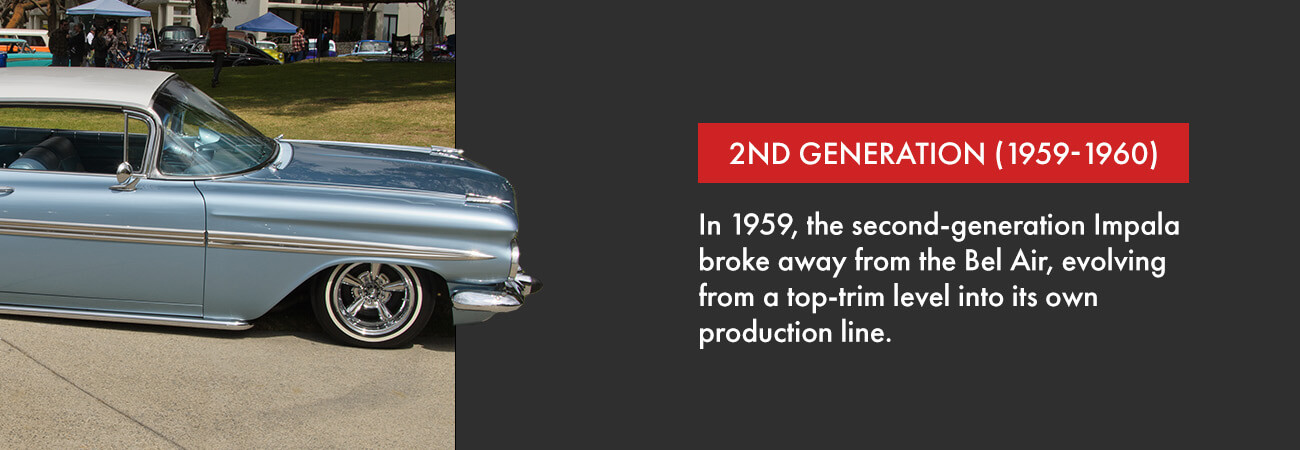
History of the Chevy Impala | Chevy Impala Guide

The Chevrolet Impala was one of the most widely liked cars ever, attracting a huge audience who loved it for its unique design and sheer power. The Impala had a versatility unlike any other vehicle. Depending on the era, you might find it on a racetrack, in a quiet suburban neighborhood, disguised as a police car or featured in a hip-hop music video.
From its golden days in the early ‘60s to its popular resurgence in the ‘90s and 2000s, the Impala’s history stretches over six decades. While its popularity ebbed and flowed, there's no question that the Impala will always remain a cherished, beloved car.
Because of this vehicle's massive popularity and unique, winding chronology, it's worth taking a look back at the history of the Chevy Impala.
Origins of the Chevy Impala
Chevrolet introduced the Impala as a concept car in 1956 at the Motorama — General Motors' (GM) car show. The five-seat hardtop design was met with excitement. Even back then, two years before the car's production, many people saw it for what it might be — muscly, agile, elegant and powerful. It had all the attributes that made its name so fitting.

The “impala” name — though not explicitly stated by Chevrolet — likely refers to a type of antelope that roams the savannas of southern Africa. Notoriously speedy, these animals can also leap distances of 33 feet and up to 10 feet high.
Although the Impala might not have these specific leaping abilities, it soon became clear that it was the type of fast, sinewy vehicle that made it feel like you could.
Early Generations (1st to 3rd)
The early generations of the Impala were full of new, sparkling designs, exciting the public and introducing something completely unique. This car's production started in the 1958 model year with the first-generation Impala.
1st Generation (1958)
For its 50th anniversary, Chevrolet sought to build new models that would attract attention and hopefully popularity. Along with a few other new models like the Cadillac Eldorado Seville and the Pontiac Bonneville and Catalina, Chevrolet also brought an innovative concept design into production with the 1958 Chevy Bel Air Impala.
The Impala, offered as a sports-coupe and convertible model, met success immediately. Built on Chevrolet's new X-frame design, the car had a unique torsional rigidity that set it apart. From the car's fundamentals to its more detailed intricacies, there was a lot to love about the new Bel Air Impala:
- Interior: With a color-matched interior, a two-spoke steering wheel and new chrome hardware, the Impala's interior styling was just as enticing as its exterior.
- Exterior: The new Impala had a famous long rear deck and shortened greenhouse. It featured dual headlights and triple taillights — three on each side — a characteristic that would cement the Impala as especially unique. The Impala sat low to the ground and displayed elegant sculpted rear fenders.
- Engines: Buyers also had their choice of engines. There was the more modest Blue-Flame 235 six-cylinder, producing 145 horsepower, and the 348 cubic-inch Turbo Thrust V8, which boasted 250 horsepower. As the Impala progressed into its second and third generations, the car would only continue to get more powerful.
2nd Generation (1959-1960)
In 1959, the second-generation Impala broke away from the Bel Air, evolving from a top-trim level into its own production line. The 1959 model went through a radical redesign, with various attributes that make it one of the most sought-after cars for Impala collectors.
This model sat lower and appeared to be more compact than the previous generation. A “bat-wing” tail sat above two “cat-eye,” teardrop-designed taillights, giving an almost angry look to the rear end of the new 1959 Impala. The overall design looked skinnier than its predecessors.
It was a fascinating, innovative design, and one that only lasted for a year. A notable “speedminder” was installed on the instrument panel, which allowed drivers to set a certain speed. When the speed was reached, a buzzer went off, alerting the driver to slow down.
Chevrolet also added a four-door hardtop and four-door Sedan to the Impala lineup. In 1960, designers moved away from provocative designs and brought back the familiar triple taillights.
Chevrolet continued to improve on performance with greater horsepower, though it wouldn't be until the third generation that the Impala would become a true muscle car.
3rd Generation (1961-1964)
The third generation marked the beginning of the Chevy Impala's golden years. This generation would see the iconic Impala SS and highlight vehicle attributes that many would remember in the decades following.
SS
In 1961, Chevrolet introduced the Impala Super Sport (SS), a car that would completely change what an Impala was. Though some SS packages Chevrolet offered were purely for appearance, the 1961 Impala SS was true to form, offering a new 360-horsepower, 409-cubic-inch V8. Stiffer suspension, manual transmission and a lot of power — this was the Impala many enthusiasts still cherish today.
The SS brought performance to the Impala that blended elegance with speed and horsepower, paving the way for many other muscle cars that came after.
Z11
If the SS Impala wasn't enough, there was also a racecar-caliber Impala engine being crafted around the same time, known as the Z11. Since these were legitimate racecars, only 50 Z11 Impalas were said to have been made. Radios and heaters were scrapped to reduce weight, and only the essentials were left in the interior.
The main attribute of the Z11 Impala, of course, was its engine — a blustering 430-horsepower, 409-cubic-inch engine. With a 13:5:1 compression ratio, special cowl induction technology and dual four-barrel carburetors, this was a monster of an engine that was exclusive to the Z11.
Design changes would also affect the third-generation Impala. The car became boxier and more compact, changing from its original elongated appearance. Edges became more rounded, and the car's overall look played to a more conservative, tidy feel. Coil springs made for a quieter and more comfortable ride. Chevrolet also looked to reduce maintenance costs for consumers, adding inner front fenders and an aluminum muffler coating to reduce rust.
The 1964 design saw a softer, more rounded version of the Impala. This year also marked the model that hip-hop culture would make popular years later, a symbol of lowrider culture.
Middle Generations (4th to 7th)
The middle generations saw another revamping of designs and the most impressive sales numbers yet.
4th Generation (1965-1970)
The fourth-generation Impala became streamlined. The X-frame was scrapped in favor of a perimeter frame, which featured curved sides, full-coil suspension and angled windshields. 1965 was also the year that the Impala broke an all-time industry record of over 1 million units sold.
Chevrolet introduced the new Caprice as the top trim for the Impala. Just as the Impala had been born as the top trim for the Bel Air, now the Caprice was doing the same, highlighting the Impala's success — and also foreshadowing its inevitable demise. The Caprice was elegant, with wood-grained accents in the interior and specialty colors like evening orchard, which was popular for women.
In 1966, designs stayed relatively the same, while new big-block engines were introduced. Chevy offered a 427-cubic-inch Mark IV V8, which produced 426 horsepower.
In 1967, Chevrolet added safety features to the Impala to keep up with new regulations. The steering column became fully collapsible, and shoulder belts were installed.
A new front end with horseshoe taillights highlighted design changes in 1968, and in 1969, the Impala station wagon was renamed “Kingswood.”

1970 marked the first year without production of the SS. Demand for muscle cars was dwindling, and new regulations were encroaching, leading to the temporary death of the SS.
5th Generation (1971-1976)
The fifth-generation Impala saw the largest car Chevrolet ever offered up to that point — the 1971 Impala, with a roomy, comfortable interior. It continued to be a best-selling vehicle.
The Caprice Classic took over the Impala convertible, and the station wagon returned. Smaller, more effective refinements were added during this generation, including:
- Cushioned front bumpers
- Variable-ratio power steering
- Interior insulation
- Corrosion-resistant frame coating
- Wear sensors on disc brakes
The improvements made the Impala safer, more comfortable and more durable. As energy regulations impacted design, this era also marked the end of the long-bodied Impalas.
6th Generation (1977-1985)
Marred by the gas crisis, differing trends in consumer culture and more safety features, the sixth-generation Impala would see its most challenging decade yet. Even throughout its struggles, the Impala continued to boast high sales.
The 1977 Chevy was downsized considerably, maintaining most of its roomy interior but shrinking its overall dimensions. The elongated back end that was unique to the previous Impalas was now less noticeable.
In 1981, Chevrolet installed the Computer Command Control (CCC) to meet government regulations. The 350-cubic-inch Oldsmobile V8 was now available for all models.
Perhaps stalled innovation led to the Impala's discontinuation after 1985. The Impala lived on, however, under the legacy of the sedan and station wagon Caprice. Great cars have a way of coming back, and Impala fans wouldn't have to wait too long before they saw a resurgence of the classic muscle vehicle.
The Impala was also immortalized by West Coast hip-hop culture, as rappers like Ice Cube rapped about the old Impala. These restored vehicles appeared in music videos and in lyrics, creating a completely new culture around the classic car even when it was out of production.
7th Generation (1994-1996)
Chevrolet designer Jon Moss sought to bring the Impala back to its former glory. At the 1992 L.A. auto show, Moss unveiled his new design — the all-new seventh-generation Impala SS concept car. Excitement bubbled around the new concept, and two years later, the SS Impala hit production.
With a 5.7-liter V8 LT-1 engine producing 260 horsepower, this was the Impala that enthusiasts had been looking for, and it marked a nostalgic nod to the great car's history. The exterior remained rounded and compact, labeled with SS badging. The car's suspension was lowered, however, and it featured dual exhaust, disc brakes and a high-capacity reverse-flow cooling system.
Adding options to the automobile's jet-black appearance, Chevrolet unveiled new colors for the seventh-generation Impala — dark cherry and green-gray.
1996 was the final year of the resurgent seventh generation. Chevrolet redesigned the instrument panel, added a tachometer and fixed the bugs from previous models. Even with these innovations, Chevrolet had to cut production once again to make room for the rise in demand for other vehicles of the era.
Modern Generations (8th to 10th)
The modern generations mark what is possibly the final years of the Chevy Impala. The 2000s transformed the Impala into a fleet car, and instead of being featured in hip-hop music videos, it was now the car of thousands of law enforcement officials.
New technology also became standard, and Chevy tried to leap ahead of the competition with additional safety standards.
8th Generation (2000-2005)
In the 2000s, Chevrolet brought back the Impala once more, built on GM's W-body platform. For the first time in its history, the Impala switched to front-wheel drive. More safety features were introduced, putting the eighth-generation Impala a few years ahead of the game regarding regulations.
An SS trim offering returned in 2004 with a 240-horsepower V6 engine. The trim also had a tighter suspension, creating a rigid, more controlled drive. The eighth-generation Impala also began utilizing new technology, including keyless remote entry, dual temperature control and XM satellite radio.
The 9C1 Police Package was also put together during this time, offering Impalas to law enforcement agencies, fire departments and Emergency Medical Services (EMS) agencies.
9th Generation (2006-2016)
After the eighth generation, the Impala started generating sales mostly from fleets that were using the vehicle as law enforcement transportation. The design became rounded with larger headlights, an updated interior featuring a new audio system, an instrument panel and updated seats. Buyers could choose from four trims: SS, LTZ, LT and LS. The SS trim included a 5.3-liter V8 engine capable of 303 horsepower.

In 2010, Chevrolet dropped the SS trim entirely, and in 2012, a universal engine was introduced to the Impala — the 3.6-liter V6 flex-fuel with automatic six-speed transmission. The new engine boasted an impressive 300 horsepower. Ninth-generation Impalas also came equipped with all the new technology — MP3 capability, Bluetooth and satellite radio.
10th Generation (2014-2020)
In 2014, designers transformed the Impala once again, adding sleekness to make it appear more modern and even elongated — a wave to its golden past. A fin on the back end was slightly reminiscent of that fascinating “bat-wing” design from 1959.
The car was also modern on the inside, with color displays and a screen in the center console for navigation and smartphone integration. Three engine options were included with the 2014 model, with the 3.6-liter V6 being the most powerful engine at 303 horsepower.
In 2020, Chevrolet ceased production of the Impala as SUVs started dominating the family car market. Was the 10th-generation Impala the last we'll see of the classic car? Every time the Impala has been discontinued, designers have found a way to revive it. This last generation, however, could be the adored vehicle's final gasp.
FAQs
The Chevy Impala's history is complicated — you might have some lingering questions that you want answered. Here are some frequently asked questions about the Chevy Impala.
What Year Is the Most Popular Impala?
Going strictly by numbers, 1965 was the most popular year for the car, with Chevrolet selling 1,046,514 Impalas. This shattered a single-model annual sales record that has yet to be beaten.
What Is the Impala Known For?

The Chevy Impala is best known for its iconic design — long back end, short greenhouse and low suspension. Because of its sprawling history, however, the Impala is known for many other things — here are a few notable mentions:
- Performance: The Impalas of the early '60s were bent on placing the vehicle in the muscle car category — and they succeeded. The SS and Z11 Impalas, with their manual transmission and monstrous engines, elevated the car to a whole new level of performance. Part of the reason the SS Impala was revived in 1994 was because of the many enthusiasts who longed for a return to the Impala's performance glory days.
- Cultural impact: In the '90s, the Impala became a West Coast hip-hop cultural icon, with iconic rappers including the '64 Impala in songs and videos. It became a symbol of lowrider culture and put the classic car back into the spotlight, even in the years of its first discontinuation.
- Fleet use: In the early 2000s, Impalas became popular cars for law enforcement fleets. Many people may now associate those ninth-generation Impalas with police cars.
What Happened to the Chevy Impala?
After six decades, the Impala was finally discontinued in 2020. Although the vehicle has made comebacks in the past, the 2020 model could be the last to roam the streets. Ultimately, the Impala's design didn't fit what consumers wanted. Larger vehicles like SUVs are more common choices for families now. The new Impala designs also failed to attract the wide audience it once did — the performance standards of the early '60s and luxurious styles were discarded for a more functional ride.
What Year Impala Is Best?
From Chevrolet's point of view, 1965 might be the best year for the Impala, since sales topped a million. For collectors, however, the best year differs — the 1959 model is consistently mentioned as one of the most unique and sought-after Chevy Impalas. With its short production, lasting only one year, and its fascinating, bold design, it's easy to see why it's so admired. The 1959 Impala featured those teardrop “cat-eye” taillights and slanted “bat-wing” fins, creating one of the most unmistakable back ends on a car ever.
The Impala's best year, of course, is subjective. Your personal "best" Impala year will depend on the attributes of the car model you favor. Whether you love designs, performance or basic functions, there's an Impala for everyone in its long and rich history.
Find Your Dream Impala at Volo
The Chevy Impala is one of the most popular and beloved cars ever. Owning a classic Impala is like owning a piece of that golden history.
If you're looking to buy your own Chevy Impala, it can be difficult to chase down a classic model, and the number of these classic cars is always diminishing. It's important to find a trusted provider that can give you a quality selection to choose from. With the right dealer, you can browse for the specific model you want and know you're getting exactly what you're buying. Going through a dealer is a convenient and reliable way to find your classic Impala.
At Volo Museum Auto Sales, we give you that convenience and reliability. Our on-site mechanics inspect our cars to make sure they're in the proper condition. We can let you take a car for a drive to test it out, and we'll assist you with post-purchase support so that you're satisfied throughout the entire buying journey. With over four generations of family experience, we are the oldest car collector dealer in existence. Find your dream Impala at Volo by browsing our collection today!





